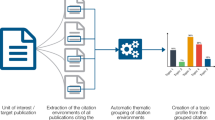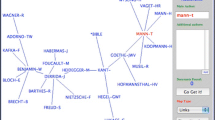Abstract
It is proposed that citation contexts, the text surrounding references in scientific papers, be analyzed in terms of an expanded notion of sentiment, defined to include attitudes and dispositions toward the cited work. Maps of science at both the specialty and global levels are used as the basis of this analysis. Citation context samples are taken at these levels and contrasted for the appearance of cue word sets, analyzed with the aid of methods from corpus linguistics. Sentiments are shown to vary within a specialty and can be understood in terms of cognitive and social factors. Within-specialty and between-specialty co-citations are contrasted and in some cases suggest a correlation of sentiment with structural location. For example, the sentiment of “uncertainty” is important in interdisciplinary co-citation links, while “utility” is more prevalent within the specialty. Suggestions are made for linking sentiments to technical terms, and for developing sentiment “baselines” for all of science.





Similar content being viewed by others
References
Argamon, S., Dodick, J., & Chase, P. (2008). Language use reflects scientific methodology: A corpus-based study of peer-reviewed journal articles. Scientometrics, 75(2), 203–238.
Börner, K., Chen, C. M., & Boyack, K. W. (2003). Visualizing knowledge domains. Annual Review of Information Science and Technology, 37, 179–255.
Charles, M. (2006). Phraseological patterns in reporting clauses used in citation: A corpus based study of theses in two disciplines. English for Specific Purposes, 25(3), 310–331.
Chen, C., Ibekwe-SanJuan, F., & Hou, J. (2010). The structure and dynamics of cocitation clusters: A multiple-perspective cocitation analysis. Journal of the American Society for Information Science, 61(7), 1386–1409.
Chubin, D. E., & Moitra, S. D. (1975). Content analysis of references: Adjunct or alternative to citation counting? Social Studies of Science, 5, 423–441.
Cohen, J. (1968). Weighted kappa: Nominal scale agreement with provision for scale disagreement or partial credit. Psychological Bulletin, 70, 213–220.
Cozzens, S. E. (1985). Comparing the sciences: Citation context analysis of papers from neurophramacology and the sociology of science. Social Studies of Science, 15(1), 127–153.
Finney, B. (1979). The reference characteristics of scientific texts. Unpublished Master’s Thesis. The City University of London.
Hargens, L. L. (2000). Using the literature: Reference networks, reference contexts, and the social structure of scholarship. American Sociological Review, 65(6), 846–865.
Harwood, N. (2009). An interview based study of the functions of citations in academic writing across two disciplines. Journal of Pragmatics, 41(3), 497–518.
Hyland, K. (1998). Hedging in scientific research articles. Amsterdam: John Benjamins Publishing Company.
Khan, K., Baharudin, B.B., Khan, A. & Faxal-e-Malik. (2009). Mining opinion from text documents: a survey. In 2009 3rd IEEE International Conference on Digital Ecosystems and Technologies (pp. 194–199). New York: IEEE.
Klavans, R., & Boyack, K. W. (2009). Toward a consensus map of science. Journal of the American Society for Information Science, 60(3), 455–476.
Kuhn, T. S. (1970). The structure of scientific revolutions (2nd ed.). Chicago: University of Chicago Press.
Kuhn, T. S. (2000). The road since structure, Chap. 4. Chicago: University of Chicago Press.
Latour, B., & Woolgar, S. (1979). Laboratory life: The social construction of scientific facts. Beverly Hills, California: Sage.
Losee, J. (1972). A historical introduction to the philosophy of science. London: Oxford University Press.
Moravcsik, M., & Murugesan, P. (1975). Some results on the function and quality of citations. Social Studies of Science, 5, 86–92.
Paquot, M., & Bestgen, Y. (2009). Distinctive words in academic writing: A comparison of three statistical tests for keyword extraction. Corpora: Pragmatics and Discourse, 68, 247–269.
Schneider, J. W. (2006). Concept symbols revisited: Naming clusters by parsing and filtering of noun phrases from citation contexts of concept symbols. Scientometrics, 68(3), 573–593.
Scott, M. (2010). WordSmith Tools Step by Step. http://www.lexically.org/wordsmith/step_by_step_guide_English.pdf.
Small, H. (1978). Cited documents as concept symbols. Social Studies of Science, 8, 237–340.
Small, H. (1986). Synthesis of specialty narratives from co-citation clusters. Journal of the American Society for Information Science, 37(3), 97–110.
Small, H. (2010). Maps of science as interdisciplinary discourse: Co-citation contexts and the role of analogy. Scientometrics, 83, 835–849.
Small, H., & Upham, P. (2009). Citation structure of an emerging research area on the verge of application. Scientometrics, 79(2), 365–375.
Swales, J. M. (1990). Genera analysis: English in academic and research settings. Cambridge: Cambridge University Press.
Teufel, S. (2010). The structure of scientific articles: Applications to citation indexing and summarization. Stanford, California: CSLI Publications.
Verlic, M., Stiglic, G., Kocbek, S. & Kokol, P. (2008). Sentiment in science: a case study of CBMS contributions in years 2003 to 2007. In: 21st IEEE International Symposium on Computer Based Medical Systems (pp. 138–143). New York: IEEE.
Author information
Authors and Affiliations
Corresponding author
Rights and permissions
About this article
Cite this article
Small, H. Interpreting maps of science using citation context sentiments: a preliminary investigation. Scientometrics 87, 373–388 (2011). https://doi.org/10.1007/s11192-011-0349-2
Received:
Published:
Issue Date:
DOI: https://doi.org/10.1007/s11192-011-0349-2




